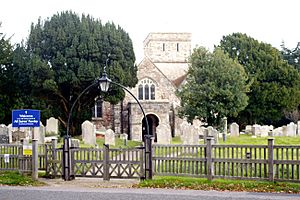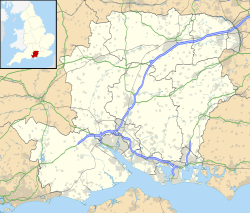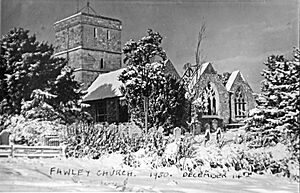All Saints' Church, Fawley facts for kids
Quick facts for kids All Saints' Church, Fawley |
|
|---|---|

The Parish Church of All Saints', Fawley
|
|
| 50°49′47″N 1°21′14″W / 50.8296986°N 1.3538568°W | |
| Location | Fawley, Hampshire |
| Country | England |
| Denomination | Anglican |
| Website | Parish of Fawley (Hampshire) |
| History | |
| Status | Parish church |
| Founded | 12th century |
| Dedication | All Saints |
| Architecture | |
| Functional status | Active |
| Heritage designation | Listed building – Grade I |
| Architectural type | Church |
| Style | Norman |
| Specifications | |
| Materials | Stone with tiled roof |
| Administration | |
| Parish | Fawley (Hampshire) |
| Deanery | Lyndhurst |
| Archdeaconry | Bournemouth |
| Diocese | Winchester |
| Province | Canterbury |
All Saints' Church is a very old church located in Fawley, Hampshire, England. It serves as the main church for the local area. This church is one of three original medieval churches found along the "Waterside" area, which is west of Southampton Water.
Contents
History of All Saints' Church
The church building you see today was mostly built in the 12th century. Construction happened in two main stages. The first stage was between 1170 and 1210. The second stage took place later, from 1300 to 1340.
There are records of an even older church on this spot, dating all the way back to 971. It's possible that some parts from that very first church were used again when the current building was constructed. The oldest part of the church is called St Nicholas's Chapel. Some people think that the church was originally named after Saint Nicholas. In 1840, a porch was added to the west entrance of the church.
Bombing During World War 2
During World War 2, in 1940, All Saints' Church was hit by a bomb. This caused a lot of damage to the building. Sadly, all of its beautiful medieval stained glass windows were destroyed.
It took many years to repair the church. It wasn't until 1954 that the church was fully fixed and opened again for services. Inside the church, there is a special plaque. It remembers the rector, Reverend John Mearing, who helped lead the efforts to restore the church after the bombing. The plaque says he inspired the restoration and the church was re-dedicated on September 12, 1954.
In the west window of St Nicholas's chapel, you can see a unique collage. It was made using pieces of the stained glass that were recovered after the bombing.
Famous People Remembered
Flight Lieutenant Samuel Kinkead
One of the memorials in the church is for Samuel Kinkead. He was a brave pilot from South Africa. Kinkead was known as a "fighter ace" during the First World War. This means he shot down many enemy planes. He was also a pilot in the famous Schneider Trophy race. Sadly, he died in 1928 while trying to set a new world record for airspeed.
Church Bells
All Saints' Church has a set of six bells. The oldest bells date back to 1603. In 1909, the four older bells were rehung, which means they were taken down and put back up properly. At the same time, two new, smaller bells were added to the set.
| Bell | Weight | Note | Date | Inscription | Bell Founder |
|---|---|---|---|---|---|
| Treble | 4cwt. 0qtr. 26lbs. | F | 1909 | John Warner & Sons | |
| 2 | 4cwt. 2qtr. 6lbs. | E♭ | 1909 | John Warner & Sons | |
| 3 | 4cwt. 3qtr. 26lbs | D♭ | 1867 | John Warner & Sons | |
| 4 | 5cwt. 3qtr. 16lbs | C | 1603 | Give God the glory | R B (of Hants) |
| 5 | 7cwt. 3qtr. 8lbs | B♭ | 1677 | Robert (?Richard?) Florey | |
| 6 | 6cwt. 3qtr. 16lbs. | A♭ | 1737 | Joshua Kipling |
The weights of all the bells were measured in August 2007. This was done by Robert Parker, a bellhanger, when the bells were rehung.



